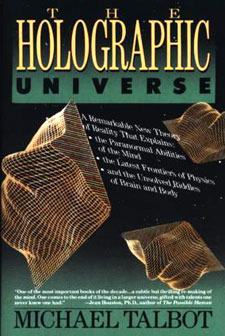The Holographic Universe
by Michael Talbot
Review By Dan Geddes
Many readers of The Holographic Universe will have doubted religion earlier in their lives, and so may be skeptical about spirituality in general. The Holographic Universe is one of those books that proposes the reunification of Eastern and Western thought: the East offering thousands of years of wisdom about the unity of all things; the West providing triumphant Science, which in turn spawns the mixed blessings of the atomization of all reality. Luckily, quantum physics, is now said to bear strong similarities to the descriptions of reality offered by Eastern religious texts, offering the hope of East/West integration.
The Holographic Universe begins by noting the inadequate model of the mind we are left with by cognitive scientists. In keeping with a philosophical materialism, psychologists have affirmed the essential physical nature of mind: thought occurs within the mind, and no thought occurs after the body is dead. Talbot however cites various studies that cast suspicion on that model. For example, Paul Pietsch did various studies with salamanders, wherein he sliced and diced their brains, scrambled and replaced them, only to find that they still retained their memories. In another study, laboratory rats had large portions of their brains removed, but still retained their knowledge of mazes. Similarly, people who have lost large portions of their brains still retain their memories. Psychologist Karl Pribam later formulated his theory that memories are distributed, not stored in a particular location throughout the brain.
The discovery of the hologram suggested a model for the brain’s apparent non-localized memory storage. Any slice of a hologram contains the entire image, albeit in miniature.
After reading about the discovery of the hologram, Pribam formulated his holographic theory of the mind, which argues that the hologram is the most appropriate model we have for unlocking the mysteries of the mind. Holograms are able to store many different images on the same piece of film if the lasers strike the film at different angles; a similar model may explain the mind’s ability to store so many memories. A holographic model would also explain why we seem to feel pain in our bodies (though the pain messages are sent from the mind), and also the phantom limb sensations that amputees feel. If the mind were like a holograph, it could be projecting these images.
If ideas like this are simply too outlandish for you to even countenance, then you certainly won’t want to read the book. The Holographic Universe states that the holographic model of the mind and of reality can explain so much that materialist science cannot. Talbot’s work is essentially a survey of research done on a wide range of topics, including physics and the paranormal, and he integrates this research with conceptions of the non-material found throughout the world’s cultures. The West has provided advanced science, but education has led to the erosion of belief in non-material occurrences, and with it the untapped powers of the mind.
Fittingly, Talbot’s approach is to show the weaknesses in the current scientific understanding of physics and other disciplines, and to explain the more satisfying explanatory power of the holographic model.
Physicist David Bohm formulated a holographic model of the universe, and so along with Pribam, he is one of the two heroes of this book. Bohm was struck by the Heisenberg Uncertainty Principle that the perceiver always affects the perceived, and so “objective” observation is impossible. For example, quanta (subatomic particles) manifest themselves as both waves and particles, but they only seem to manifest themselves as particles when they are being observed. If this is true, this threatened the authority of scientific experimentation. Bohm formulated the idea of non-local interconnectedness to explain the uncanny relationship that may exist between perceiver and perceived, as well as between different particles of the same system.
Bohm later wrote a distillation of his ideas called Wholeness and the Implicate Order, which posited implicate and explicate orders. For Bohm, the universe is a holomovement between the two orders, the explicate, which we call everyday reality, and the implicate order, wherein phenomena such as subatomic particles reside. Bohm’s theory explains problems such as the effect of consciousness on the external world. Although his theory has received repeated experimental support, predictably it has been resisted by physicists.
Pribam and Bohm are the twin pillars of The Holographic Universe,which goes on to explore psychological and psychic phenomena, and to include a wide diversity of ideas that fit the holographic model. The holographic model of the mind is more conducive to explaining such ideas as Jung’s collective unconsciousness, and the intersubjectivity (thought-sharing) that people have experienced with and without the aid of LSD, and the experiments that have demonstrated that through conscious effort people can affect the dreams of others.
As said, skeptics may well set aside The Holographic Universe well before completion. They may be well take it as a sad sign when phenomena such as telekinesis are used as evidence for a theory such as the holographic universe. Yet Talbot is unapologetic as he introduces the research that purports to demonstrate the paranormal powers of the mind and that continues to confound skeptics.
If you are open-minded, The Holographic Universe may well tantalize you with the possibility that the gray deterministic universe posited by Western science is indeed in error, and that the universe is more magical than meets the eye. Due to the specialized nature of so many of the experiments cited by Talbot, it is difficult for the lay reader to come to any definitive conclusions. But Talbot documents the studies for readers’ corroboration. Perhaps you will feel that some of the ideas resonate with things you have heard before, and you will want to look at some of the works cited. (Although there are full citations in the endnotes, this book could have used a bibliography.)
While I remain skeptical about much of the data presented by The Holographic Universe, it is pleasant to encounter one way around the logjam upon which so many currents of thought are now stuck. People now believe in matter (clearly a formulation!) with the same dogmatism that others once believed in the Christian God. Scientific breakthroughs are always achieved by those who can see the world completely anew, rather than plod along the same course imagined by others, the visionaries, years before.
February 2001






Be First to Comment